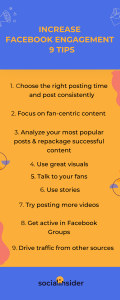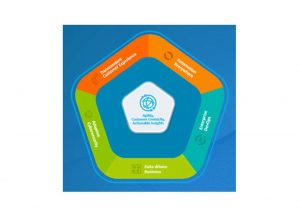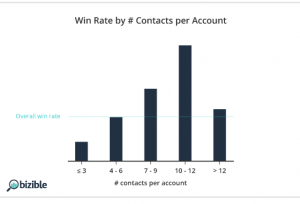Are misconceptions holding back your email marketing campaigns? Learn a better approach to build your subscriber base.
Email marketing is getting both widespread and less effective, per a recent Insider Intelligence report. This might suggest that as a discipline, we’ve maxed out — or will soon max out — our optimal usage.
We work with dozens of CPG, ecommerce and D2C brands, and our onboarding process repeatedly shows that almost none have come close to maxing out their email potential.
So what’s holding email marketers back from maxing sends and growing their subscriber list in the process? In this article, we’ll look at:
- What misconceptions are holding email marketers back.
- A better approach to email campaigns.
- How to build your subscriber base.
- The benefits (including some under-appreciated ones) of getting email right.
Email marketing misconceptions
We hear two frequent misguided sentiments from our brand-side contacts:
- They don’t have enough content to deploy for effectively expanded email campaigns.
- They’re afraid of turning off users with too many sends.
As far as content goes, marketers generally have much more available than they realize. Without creating anything completely new, they can usually access things like case studies, testimonials and existing blog posts to repurpose effectively. The key that often gets overlooked is thinking through the user experience so you can understand what content will add value for the user.
Let’s say someone viewed a product page on your site for sliced cheese. You may have a handful of popular sandwich recipes that would make for an engaging follow-up email.
On the B2B side, if someone visits a blog post addressing a specific business challenge, an email with a case study about overcoming that challenge would add immediate value. Unless you’re starting from scratch, without a blog or social media or case studies or customer reviews, you have more to work with than you think.
The last under-used content opportunity tends to be a lack of follow-through on big initiatives. Our clients often put together big ideas for monthly campaigns, but they don’t think of a quick follow-up for those who open the email. Sending a valuable follow-up four days later is a quick and easy way to compound value with minimal additional effort.
Marketers might understand all of that and still be wary of excessive frequency. For instance, a client asked me point-blank once (not at the height of COVID) why I thought we could email weekly about toilet paper and be effective. And if you’re using a blanket and/or static approach, that fear is valid.
A better approach to building email campaigns
Ideal email campaigns are rooted in understanding the customer journey, which shows potential triggers you can address by repurposing content or producing new content with particular deployment intent.
The second critical piece of this approach is automation. Once you have your customer journey steps mapped out, automatic email journeys should follow. For each step, determine the next steps and the attendant messaging to drive value.
Why did the user engage, what would likely entice them to engage further and what kind of messages would serve the purpose? Building that content in an automated sequence has proven to drive results for our clients.
The natural starting point doubles as the most consequential initiative for engaging subscribers: your welcome series. We have found, over and over, that people who engage with emails within the first seven to 30 days are likelier to be long-term engagers. You have one chance to get that right, so consider how to personalize your welcome series based on engagement.
Essentially, adjust your strategy to look less like this:
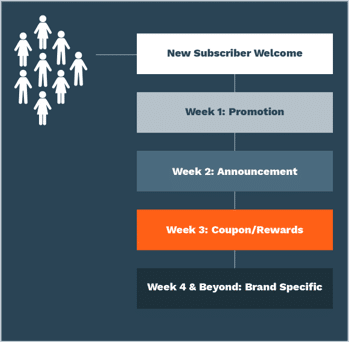
And more like this:
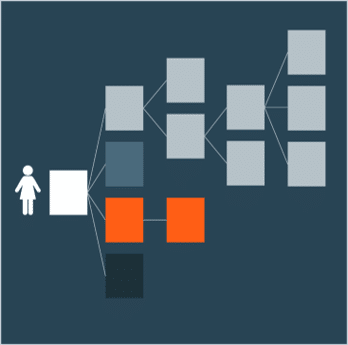
The benefits are real. We’ve seen that early engagers tend to yield open and click rates that are more than 200% higher than new subscribers who stay dormant through the first 30 days.
Many of our brands use this data to create efficient churn processes to segment non-engagers quickly into journeys that will receive far fewer sends and only graduate them back to the main segment when they engage. This process helps avoid over-sending to subscribers who will not become part of their most loyal segment.
The welcome series is a great starting point that adds the benefit of signal data. Double down on early engagement to develop progressive profiling and personalized content to match to move early engagers further into the journey.
For example, one of our clients ended up building a parenting-focused path for early users who engaged with kid-related content and the engagement numbers were double-digits higher than we’d seen before we created the segment.
How to build your subscriber base
The compounding growth factor of better subscriber engagement is bringing in more subscribers from the beginning. There are plenty of paid techniques and channels I could recommend here. Still, the lowest-hanging, most cost-effective fruit tends to be taking advantage of all opportunities to ask for user information on your owned properties, primarily your website. Whenever a user looks to buy something or enter information, give them an opt-in box to convert them to subscribers.
Your site has ready-made checkpoints, such as getting to the end of a blog post, downloading a recipe or user manual and downloading a price-comparison PDF. Tools as simple as lightboxes and prominent opt-in boxes on thank-you pages are steps marketers often overlook, which is a lot like forgetting to tag home after rounding the bases.
The benefits of a better email strategy
Yes, you’ll see more direct revenue coming from your base of subscribers, but the benefits go beyond that. More first-party data in your system enables you to add nuance and variety to user experiences and recommendations — not just via email. First-party data opens up a ton of profile targeting on advertising channels (particularly paid social).
Expand that into offline attribution, where a known subscriber takes action in brick-and-mortar stores, and you’ll have a ton of three-dimensional data that informs strategic, personalized campaigns.
As major advertising platform engagement costs continue to rise, email is getting more attention as a cost-efficient growth channel. Make sure you’re zooming out and building a strategy that optimizes your time and tech investments, entices more users to join your community and builds valuable connections for the long term.
The post How to send more emails and grow your subscriber list appeared first on MarTech.
(5)



